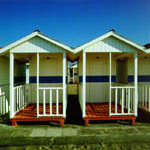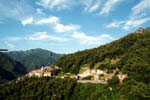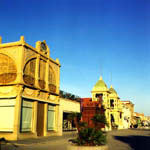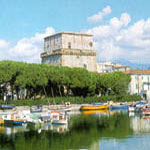|
The territory of Versilia covers an area of about 160 square kilometres in the North-Western coast. Froman administrative point of view, it is a part of the province of Lucca.
 The area has always had a natural tourist vocation as balneotherapy teatments started here during the second hal of 19th century with tha building of the first bathing establishments. The area has always had a natural tourist vocation as balneotherapy teatments started here during the second hal of 19th century with tha building of the first bathing establishments.
Nowadays Versilia is not only a beautiful stretch of coast but it also provided excellent opportunities to spend enjoyable holidays the whole year round, thanks to ita mild climate and teh wide range of entertainment and leisure facilities available.
Tha area is an important base to reach major Tuscan art cities such as Lucca, Pisa, Florence, Siena, San Giminiano and Volterra, reachable in a reasonably short time.
From a naturalistic point of view, the area is well known for safeguarding the environmente with a rich diversified natural landscape comprising the majestic mountains of the Apuan Alps - offering a magnificent backdrop to the colourful coastline - consisting in some of the hightest peaks in the region. These are part of the well-known Apuan Alps Regional Park, providing an ideal environment for trekking, walking, cycling, horse riding or mountai climbing. To the South extends the Migliarino-San Rossore-Massaciuccoli Regional Park offering a wide variety of habitats, from the lush coastal pine wood to the salty swamps and lake. Both nature parks are ideal for people of all ages and fammilies and can be enjoyed the whole year round. Furthermore, sea lovers can enrich their holidays consisting in dolphin and whale-watching cruises to the Cetacean Sanctuary, a water reserve located along the Tuscan Archipelago and the northern Tyrrhenian Sea - where these animals can be observed in their natural habitat.
The sea: Versilia, boasts 20 km of uninterrupted sandy shore from Torre del Lago Puccini, stretching as far as Vittoria Apuana (Forte dei marmi) in the north. The sea-bathing tradition of the region dates back to 1833 when Giuseppe Giannelli, a physician involved in medical hydrology, published the first study on the subject entitled "Il manuale per i bagni in mare" (Treatise on sea-bathing), qualifying Versilia as a beach of tradition. The sea-bathing tradition of the region dates back to 1833 when Giuseppe Giannelli, a physician involved in medical hydrology, published the first study on the subject entitled "Il manuale per i bagni in mare" (Treatise on sea-bathing), qualifying Versilia as a beach of tradition.
Construction of the original bathing establishments began in the early 1900s with boardwalks and chalets. Since then Versilia beaches have created a trend from which its culture, entertainment and jet set originated.
Today Versilia is in a position to offer a wide range of facilities ranging from affordable public beaches to more sophisticated bathing establishments - capable to satisfying even the most demanding requirements - providing bars, swimming pools, restaurants and night-clubs. An extensive range of accomodation facilities can also be found in the area, from camp grounds to small family-run hotels to luxury hotels with different architectural designa and setting and equipped with all sorts of comfort.
The vegetation: the territory encampasses a richly variety landscape, forming a harmonic blend, from sandy coastal dunes, to extensive luxuriant pinewoods and mediterranean macchia (brush), alternating with sections of cultived plots of land.
Thanks to the abundant number of waterways, the forest of the macchia contains a great variety of trees, including British oak, ash and black alder trees. Of great naturalistic value are the artificial pinewoods planted by man, full of thick Mediterranean underbrush and trees such as hornbeams and poplars.
The Fauna: both the coastal and inland habitats abound in fauna. Birds who find the swamp system of Massaciuccoli along their migratory route enrich the natural patrimony in Versilia. A rich variety of mammals live in both the coastal waters and inland territories.
The pine wood: the vast pinewoods in Versilia, partly included in the Migliarino-San Rossore-Massaciuccoli Nature Park, were planted by man in the 17th and 18th centuries. They consist of cluster pine (pinus pinea), a species imported to Italy during the roman epoch, when it was well-known above all along the Tyrrhenian coast and in sicily.
Its spread over vast areas is due to the fact thet every part can be exploited: from the trunk, to obtain timber, to the bark and resin used for dyes and chemical products, to the seed, the pine nut.  During the 1930s the pine tree industry became extremely important to Versilia's economy. Even if Versilia is still today one of the largest areas for the production of pine nut in Italy, the value of its pinewood today is above all naturalistic. During the 1930s the pine tree industry became extremely important to Versilia's economy. Even if Versilia is still today one of the largest areas for the production of pine nut in Italy, the value of its pinewood today is above all naturalistic.
Of these woods, perhaps the most famous one is the Versiliana Park at Marina di Pietrasanta, which covers approximately 80 hectars celebrated in the verses of the poete Gabriele D'Annunzio. Today it is property of the Pietrasanta municipality and is venue for interesting cultural events.
History: the Human presence in Versilia dates back to the Neolitic Age and many traces still remain in a number of areas. Then the Apuan Ligurians occupied the territory and fortified mountain passes and hills. Subsequently the Etruscans left but very few traces in the area.
When the Romans arrived, they built roads such as the ancient Via Aurelia and colonized the artea with villas, hamlets and villeges. The Lombards later occupied the Roman settlements, providing the territory with a layout similar to tha present one.
A major development in Versilia's history was the founding of the two principal cities: Pietrasanta in the north and Camaiore in the southern area. Pietrasanta was dominated by Lucca, Pisa and Genoa and finally, in 1513, it went under control of Florence. Camaiore was instead under the rule of Lucca. These two cities have played an important role in the area up to 1700 but during the following years - with its port and land reclamation operations - Viareggio grew in importance and began to expand until it obtained the dignity of a city.
Towards the end of the first half of the 19th century Versilia gradually became well known as a halthful place for sea bathing and heliotherapy treatments. This trend turned the area into a growing holiday destination, becoming popular among pleasure seekers as well as those pursuing cures.
At the end of the 19th century the popularity of bathing expanded enormously throughout the region leading the area to the present situation.
Architecture and art: the artistic heritage of Versilia boasts many monuments preseved in the numerous tows and villages scattered in the countryside. In Seravezza one can admire the Cathedral, dating to 16th century with its polychrome marbles as well as the 15th century baptismal font found in the inside by the Stagio Stagi, an architect from Pietrasanta. Then the Medici Palace with ita imoressive portal built in 1555 by Barolomeo Ammannati for Cosimo I of the Medici Family. Also outstanding is the Romanesque parish church of San Martino, situated in the mountain hamlet of Azzano. At Stazzema you can admire the 12th century Romanesque Church of Santa Maria Assunta, with several precious 15th and 16th century paintings and sculptures.
The Historic town of Pietrasanta contains the main monuments on the cathedral Square, such as the Duomo of San Martino, built in 1330 with a magnificent marble facade decorated by three blind arches. On the southern side is the Rocchetta Arrighina, a small fortress dating to 1324, rebuilt in 1487, and connected to the Porta a Pisa (City gate to Pisa), the only remaining gate of the ancient city walls.
At Camaiore you can find the splendid Romanesque Collegiate Church dating to 1278, rising on the square dedicated to San Bernardino da Siena who preached here in 1410.
Also remarkable is the small Church of San Michele with a Romanesque layout as well as the Confraternity of the SS. Sacramento housing the Museum of Sacred Art. Finally, near the cemetery is the impressive benedectine Abbey dating back to 11th century.
Versilia District: Camaiore: the village is located at the bottom of a valley surrounded by hills as well as the northern Appenines. Small town founded in Roman times with the typiacl orthogonal layout, it contains many artistic tresaures like the well known Collegiate Church and Benedectine Abbey. Due to the ideal location and characteristics of the territory, many Americans and English people have settled in this untouched countryside following the example of prominent italian families like Mondadori. The local economy is based on specialized agriculture and tourism with most of the hotels, bathing clubs and restaurant located in Lido di Camaiore, its seaside resort.
 Forte dei Marmi: It is the most recent municipality, having been founded in 1914. Its territory borders Marina di Pietrasanta in the south and stetches up to Cinquale in the northern part. The modern area is built around its small historic centre near the fort, dating from 1782. Today, its pier stretching out into the sea for about 100 metres, is frequented by strollers and fishermen but in the past was used to transporting marble from the Apuan Mountains. On clear days a breath-taking scenery of the sea and mountain can be enjoyed from here and the Apuans seem almost to soar above the sea. Today it is a very popular destination for tourists from all over the world. In the 1930s Agnelli family chose the town for their summer residence making famous and starting a trend for many other wealthy industrial families coming from northern Italy who continue to spend their holidays here. Roma Imperiale, to the south of the town centre, is a maze small streets lined by a magnificent villas completely surrounded by luxuriant vegetation where the night life is enjoyed with moderation but can be as exciting as in the most famous resort in Sardinia. Forte dei Marmi: It is the most recent municipality, having been founded in 1914. Its territory borders Marina di Pietrasanta in the south and stetches up to Cinquale in the northern part. The modern area is built around its small historic centre near the fort, dating from 1782. Today, its pier stretching out into the sea for about 100 metres, is frequented by strollers and fishermen but in the past was used to transporting marble from the Apuan Mountains. On clear days a breath-taking scenery of the sea and mountain can be enjoyed from here and the Apuans seem almost to soar above the sea. Today it is a very popular destination for tourists from all over the world. In the 1930s Agnelli family chose the town for their summer residence making famous and starting a trend for many other wealthy industrial families coming from northern Italy who continue to spend their holidays here. Roma Imperiale, to the south of the town centre, is a maze small streets lined by a magnificent villas completely surrounded by luxuriant vegetation where the night life is enjoyed with moderation but can be as exciting as in the most famous resort in Sardinia.
The incomparable Wednesday-morning weekly market in Marconi's Square is famous all over Italy.
Massarosa: located at the foot of the hills, the territory became inhabited ever sonce the pre-historic age with peculiar environmental features. It consist of lake Massaciuccoli, cherished and celebrated by the famous composer Giacomo Puccini, as weel as the hilly area cultivated with the vineyards and olive groves which, along with the home cooking of its restaurant, makes it a haven of peace, ideal to spend an afternoon away from the bustling life at the beach.
Pietrasanta: Pietrasanta is a town of considerable artistic and cultural importance situated at the foot of the ancient Lombardic Fortress overlooking the buil-up area around the magnificent piazza del Duomo full of marble workshop and numerous sculpture studios. Artists of all nationalities work and meet in the town, creating an intense artistic activity and duriong the summer these organize exhibitions as well as "one man shows" in relationship to more important events.
Marble carving courses are also available for young artists from avery part of the world
The town also hosts the Museum of Models where sketches and models of famous italian and foreign artists are displayed. Thanks to all these cultural initiatives, the town has been defined Little Athens. Marina di Pietrasanta. the seaside resort, offers numerous welcoming cafès and discos in addition to a beautiful wide sandy beach and a clean sea.
Seravezza: the town is situted at the foot of the Apuan Alps and its origins are medievale. Its mountainous territory is characterized by marble quarries, the main source of wealth of the place, highly sought after ever since the 15th century, to such an extent that actually Michelangelo came here to choose the raw for his works of art. Of considerable interest is the 16th century Medici Palace, nowadays a venue for exhibitions and cultural events, in addistion to a well-equipped Museum of Work and Popular Traditions.
Stazzema: Nestled on the slopes of Monte Matanna and surrounded by the fasinating peaks of the Pania della Croce and Corchia, the village of Stazzema is an ideal starting point for excursions to the Park of the Apuan Alps. The first historic traces date back to the 9th century, when the construction of the Church Santa Maria Assunta began. Not far from the town is the Antro del Corchia - a huge karsic cavern - recently opened to the public. In the area is the village of Sant'Anna, where one of the most horrendous massacres by the nazis took place in 1944. On a hill a monument to Peace has been erected as a symbol for mankind.
Viareggio: largest municipality in Versilia with an ancient centre dating back to the 12th. Its name derives from the Via Regia, which joined the coast to the hinterland during the Middle Ages. The city is a renowned seaside resort, with its economy based on tourism, trade, fishing and floriculture. It boasts an efficent tourist port containing 500 boats. Viareggio's shipyards are famous all over the world for the building, maintenance and repairing pleasure boats, mostly yachts.
Towards the end of the 19th century boat building gave the inhabitants of Viareggio the idea for the construction of the first carnival floats supported by a wooden skeleton. In the course of time these became today's artistically created papier machè floats.
The Viareggio Municipality also includes Torre del Lago Puccini, home to the Maestro Giacomo Puccini where he lived and composed many of his operas.
Texts and photo are published by gentle permit of Versilia's Tourist Agency |



 Munch: The Scream Within
Munch: The Scream Within In the garden
In the garden Perugia Travel Guide
Perugia Travel Guide


 The area has always had a natural tourist vocation as balneotherapy teatments started here during the second hal of 19th century with tha building of the first bathing establishments.
The area has always had a natural tourist vocation as balneotherapy teatments started here during the second hal of 19th century with tha building of the first bathing establishments.  The sea-bathing tradition of the region dates back to 1833 when Giuseppe Giannelli, a physician involved in medical hydrology, published the first study on the subject entitled "Il manuale per i bagni in mare" (Treatise on sea-bathing), qualifying Versilia as a beach of tradition.
The sea-bathing tradition of the region dates back to 1833 when Giuseppe Giannelli, a physician involved in medical hydrology, published the first study on the subject entitled "Il manuale per i bagni in mare" (Treatise on sea-bathing), qualifying Versilia as a beach of tradition.  During the 1930s the pine tree industry became extremely important to Versilia's economy. Even if Versilia is still today one of the largest areas for the production of pine nut in Italy, the value of its pinewood today is above all naturalistic.
During the 1930s the pine tree industry became extremely important to Versilia's economy. Even if Versilia is still today one of the largest areas for the production of pine nut in Italy, the value of its pinewood today is above all naturalistic.
 Forte dei Marmi: It is the most recent municipality, having been founded in 1914. Its territory borders Marina di Pietrasanta in the south and stetches up to Cinquale in the northern part. The modern area is built around its small historic centre near the fort, dating from 1782. Today, its pier stretching out into the sea for about 100 metres, is frequented by strollers and fishermen but in the past was used to transporting marble from the Apuan Mountains. On clear days a breath-taking scenery of the sea and mountain can be enjoyed from here and the Apuans seem almost to soar above the sea. Today it is a very popular destination for tourists from all over the world. In the 1930s Agnelli family chose the town for their summer residence making famous and starting a trend for many other wealthy industrial families coming from northern Italy who continue to spend their holidays here. Roma Imperiale, to the south of the town centre, is a maze small streets lined by a magnificent villas completely surrounded by luxuriant vegetation where the night life is enjoyed with moderation but can be as exciting as in the most famous resort in Sardinia.
Forte dei Marmi: It is the most recent municipality, having been founded in 1914. Its territory borders Marina di Pietrasanta in the south and stetches up to Cinquale in the northern part. The modern area is built around its small historic centre near the fort, dating from 1782. Today, its pier stretching out into the sea for about 100 metres, is frequented by strollers and fishermen but in the past was used to transporting marble from the Apuan Mountains. On clear days a breath-taking scenery of the sea and mountain can be enjoyed from here and the Apuans seem almost to soar above the sea. Today it is a very popular destination for tourists from all over the world. In the 1930s Agnelli family chose the town for their summer residence making famous and starting a trend for many other wealthy industrial families coming from northern Italy who continue to spend their holidays here. Roma Imperiale, to the south of the town centre, is a maze small streets lined by a magnificent villas completely surrounded by luxuriant vegetation where the night life is enjoyed with moderation but can be as exciting as in the most famous resort in Sardinia.